I shoot about 50% film and 50% digital these days. For digital I shoot with the Fujifilm X series cameras and lenses. Fujifilm cameras appealed to me several years ago because of the retro styling and film camera like controls for shutter speed, ISO and aperture. I also loved the ability to use Fujifilm film emulsion filters on the in camera jpgs such as Velvia, Acros, Provia, Astia, Classic Chrome and PRO Neg to name a few.
I love shooting film on a variety of 35mm and 120 cameras because the process of slowing down and thinking about a shot elicits a certain mindfulness to my photography. With film I carefully consider each shot and I slow down. There’s no spray and pray with a roll of 36 exposures. With film, the process and experience of finding and executing the shot is as important and satisfying as the final image itself. There’s a certain Zen with acknowledging your limitations and working through them to find the perfect capture.
Another reason for shooting film is the ‘look’ that is magic. Magic, the noun, is defined as “the power of apparently influencing events by using mysterious or supernatural forces” and as an adjective as “wonderful; exciting”. Shooting film relates to both the mysterious and exciting.
The film developing was done in home. Using a combination of chemicals, mix ratios, agitation, drying and working film out of canisters and onto developing reels in total darkness reminds me of ancient alchemy. And at the end of this mysterious alchemical process, I find images – moments trapped in time, that have spontaneously appeared on a piece of celluloid. Sometimes the moments captured are from times I can not recall but, there they are, captured for all eternity as if by magic on these rolls of film and they are beautiful.
When Fujfilm announced late last year they are updating their digital rangefinder, the XPro series, to provide a more film-like shooting experience, I was intrigued and excited. The Fujifilm XPro3 does away with the back LCD screen and instead has a small window reminiscent of a film memo holder. This little memo holder display looks as if you have just torn off the side of a box of film and inserted it into the memo holder. The back panel does tilt down to reveal a traditional LCD screen with all the info you would typically find on a Fujifilm X Series camera.
And lastly, the XPro3 rangefinder has a hybrid viewfinder that can display a more traditional looking optical electronic viewfinder giving you a natural view of your scene with frame lines to equate with the lens focal length. This is great for those who enjoy seeing bits of the scene outside of the captured image and allows for easier framing of shots. It also can be quickly switched to a traditional LCD viewfinder.
The release of the Fujifilm XPro3 camera coincided with me getting some recently re-released Fujifilm ACROS 100II film. Given my love of Fujifilm digital cameras, film photography and ACROS film, I desperately wanted to shoot and compare the new XPro3 alongside a rangefinder film camera. The good people at Fujifilm Australia were kind enough to send me a XPro3 to use for a couple of weeks to satiate my desire.
For my Fujifilm ACROS shootout I dusted off a Yashica Electro 35 GSN with a 45mm f/1.7 lens. I placed a red filter on the lens and loaded the Fujifilm ACROS 100II 35mm film.
The XPro3 is a crop sensor camera so I attached a 27mm (41mm full frame equivalent) f/2.8 lens to the XPro3 and dialed in the ACROS -R film simulation. The -R is the ACROS simulation with a simulated red filter. So in theory, I had two rangefinders with very similar specs.
I threw both cameras in my car and carried them around for the 2 weeks pulling them out to take identical photos around my home on Phillip Island, Australia.
Once 36 exposures were taken, I used a stand developing method with a 1:100 Rodinal solution to develop the film and scanned the images on an Epson V550 scanner.
Here’s the big reveal – image comparisons. The top or left image is the 35mm ACROS 100II image and the bottom or right image is the ACROS -R JPG digital image.
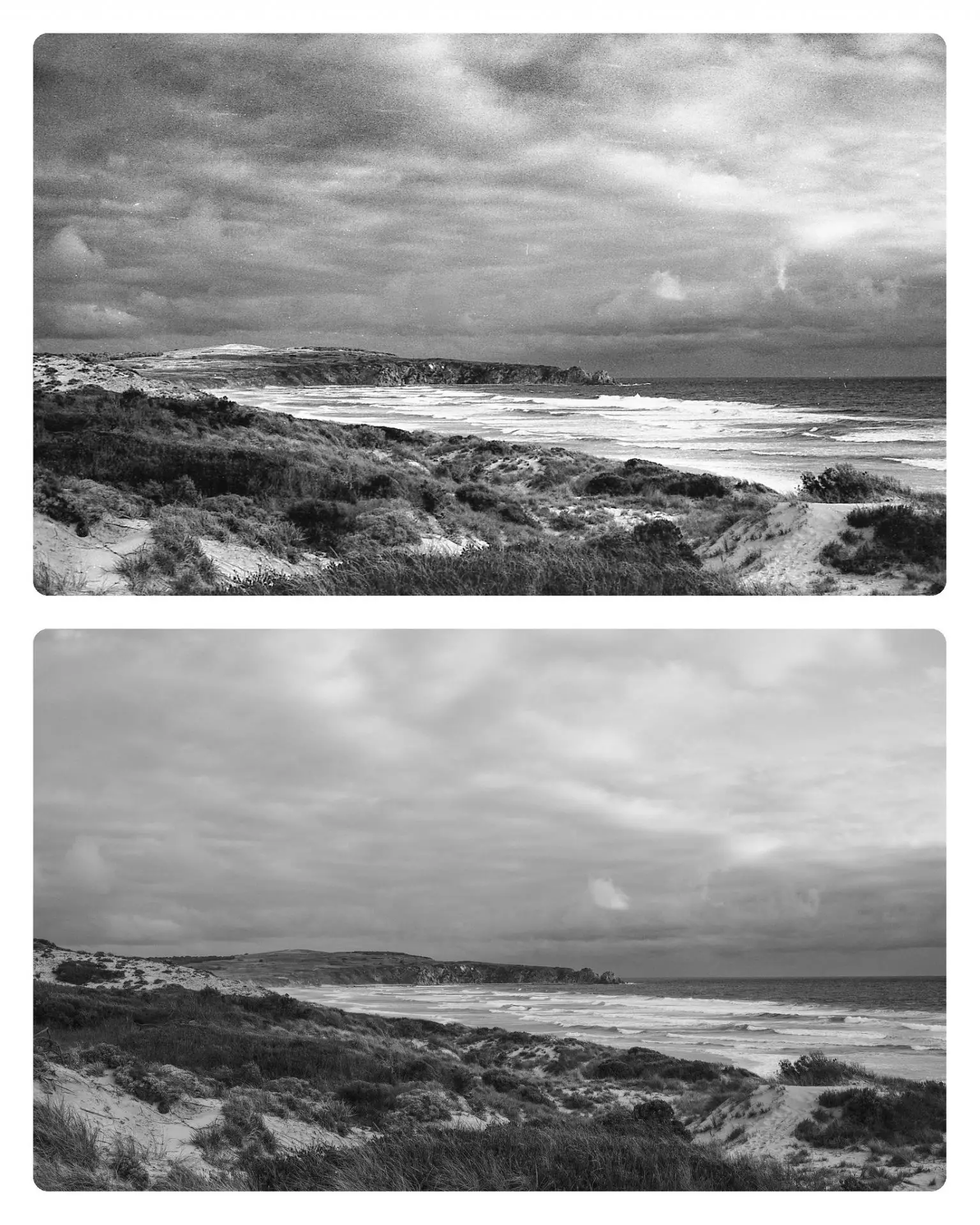
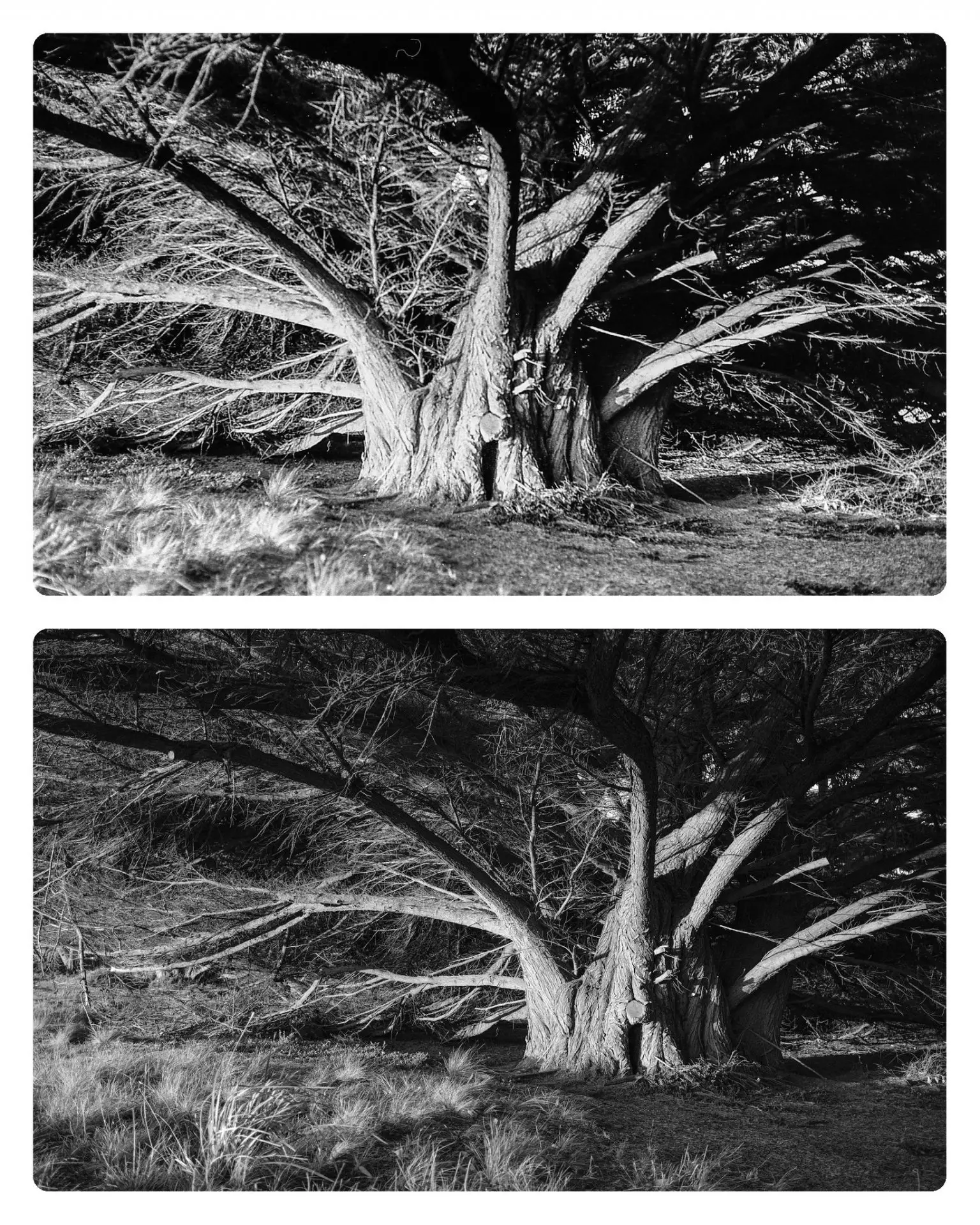
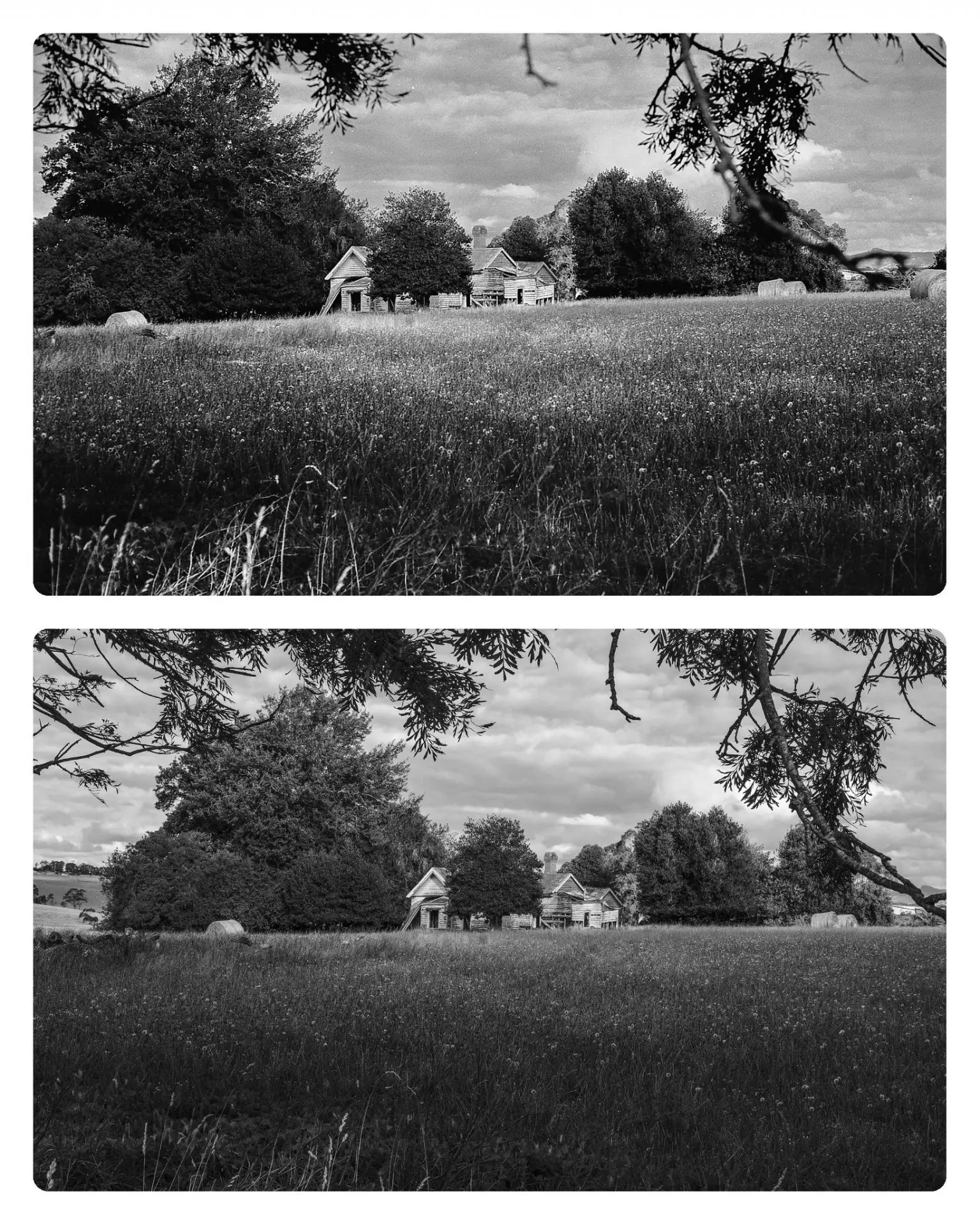
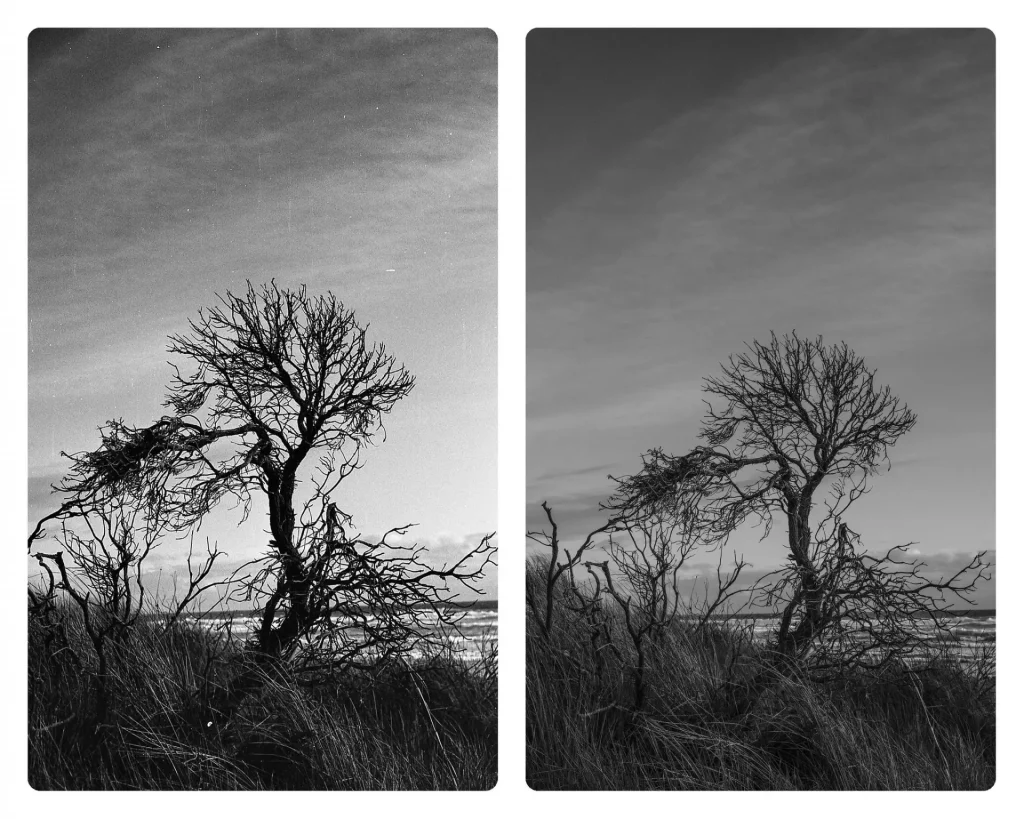
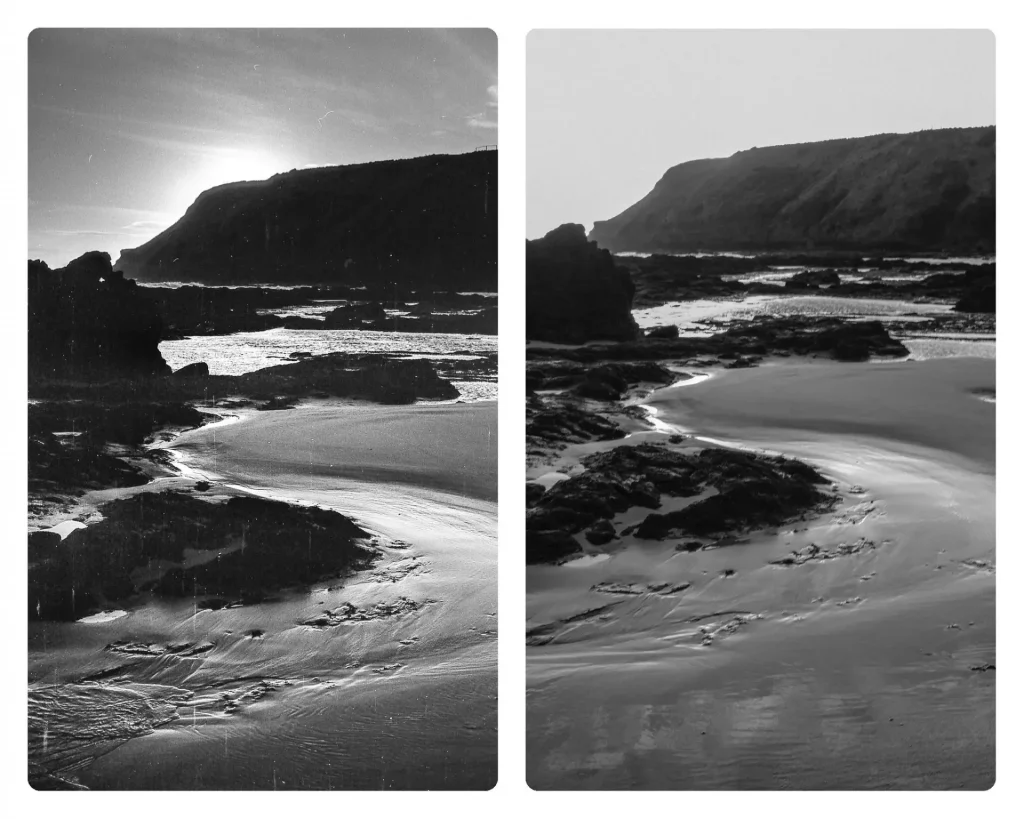
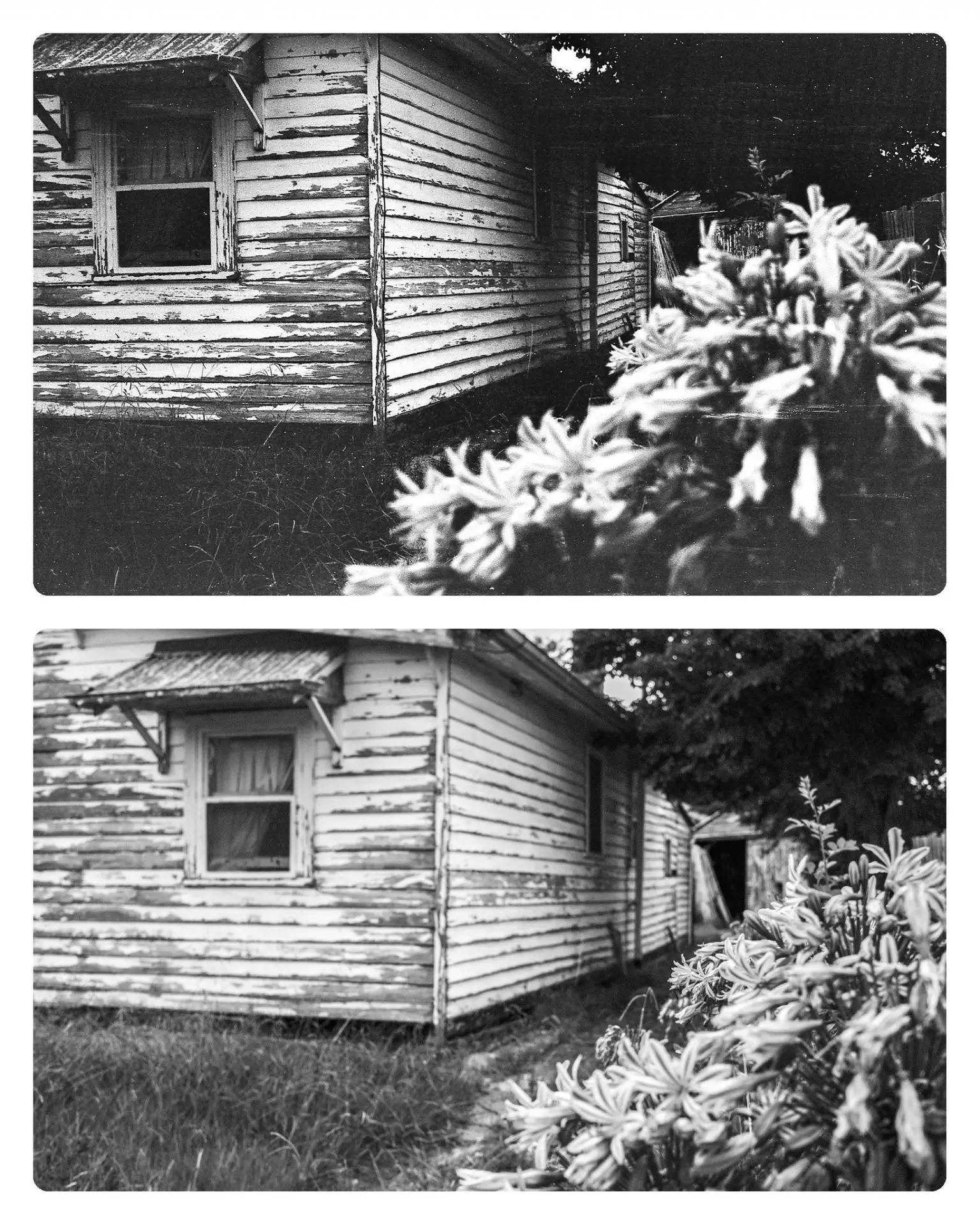
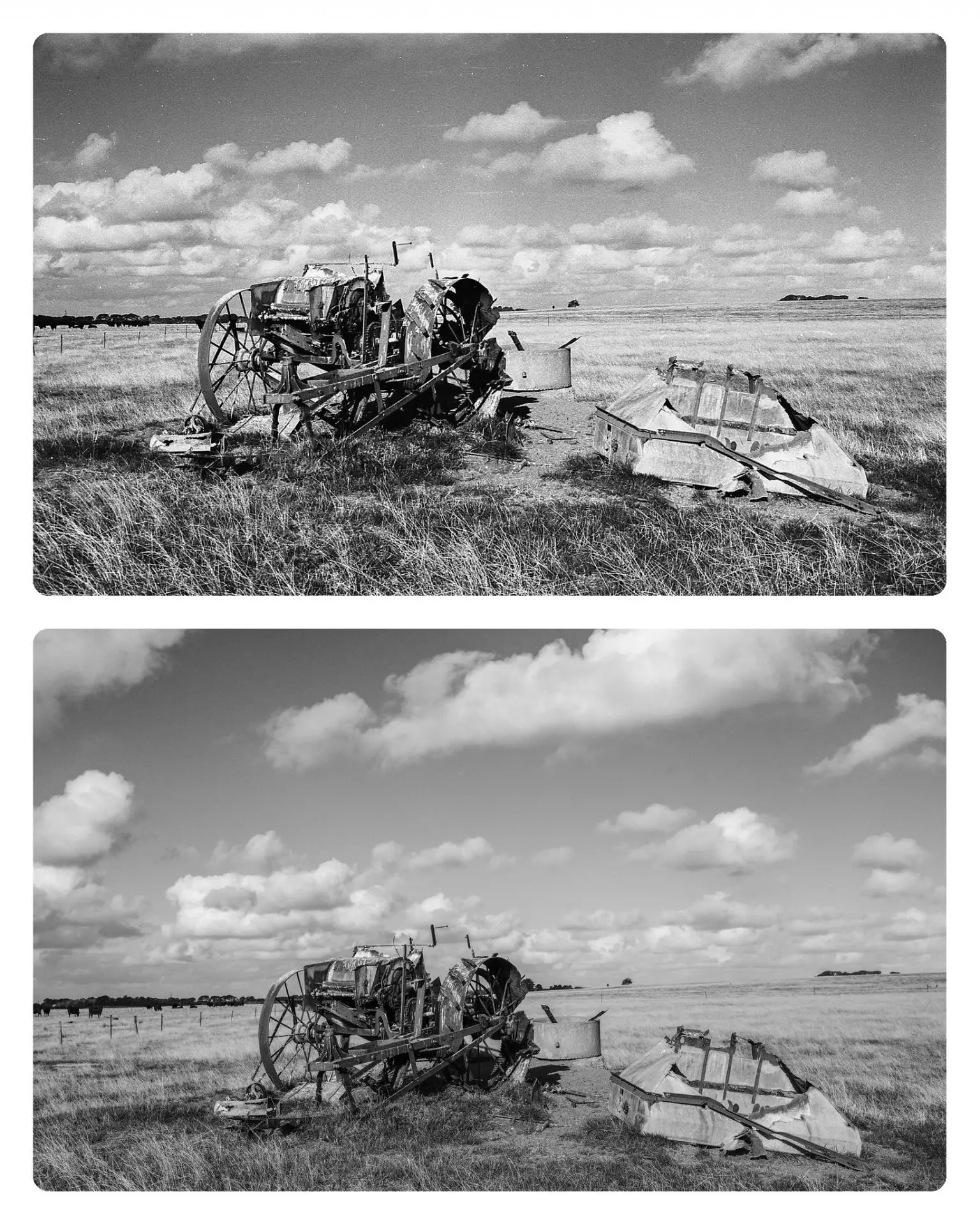
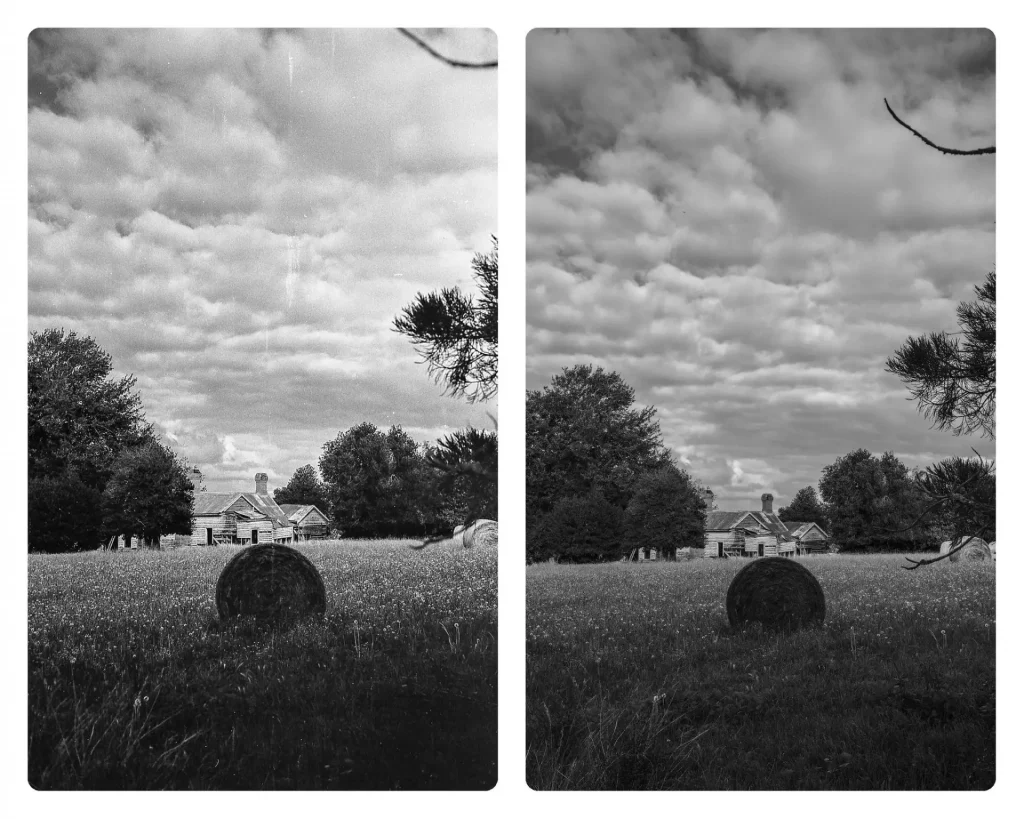
These shots look pretty similar. Fujfilm did a great job on the ACROS digital film simulation. I was surprised the shots were similar in look and feel. However they do exemplify the differences between digital and film. From these images I have a much greater appreciation for the way film preserves and manages highlights. They look superb. Of course the digital sensor excels at shadow recovery even in a jpg file.
As for the XPro3, I like the rangefinder feel especially when using the optical viewfinder. It does help to recreate a film shooting aesthetic. I probably would not use this camera out shooting landscapes as I found the backscreen cumbersome when flipped down as I changed camera orientation or as a serious wildlife/sports camera. I put a 100-400mm f/4.5-5.6 on the body and it did not have the same balance and feel as my XT-3. However, It’s a super fun camera to shoot and I reckon it would excel as a street shooter and add a little interest and fun to the digital experience.
Which images do you prefer?
http://photorangers.com.au
https://www.facebook.com/photorangers/
Digital – https://www.instagram.com/photo_rangers/
Film – https://www.instagram.com/salamanderrepublic/
Share this post:
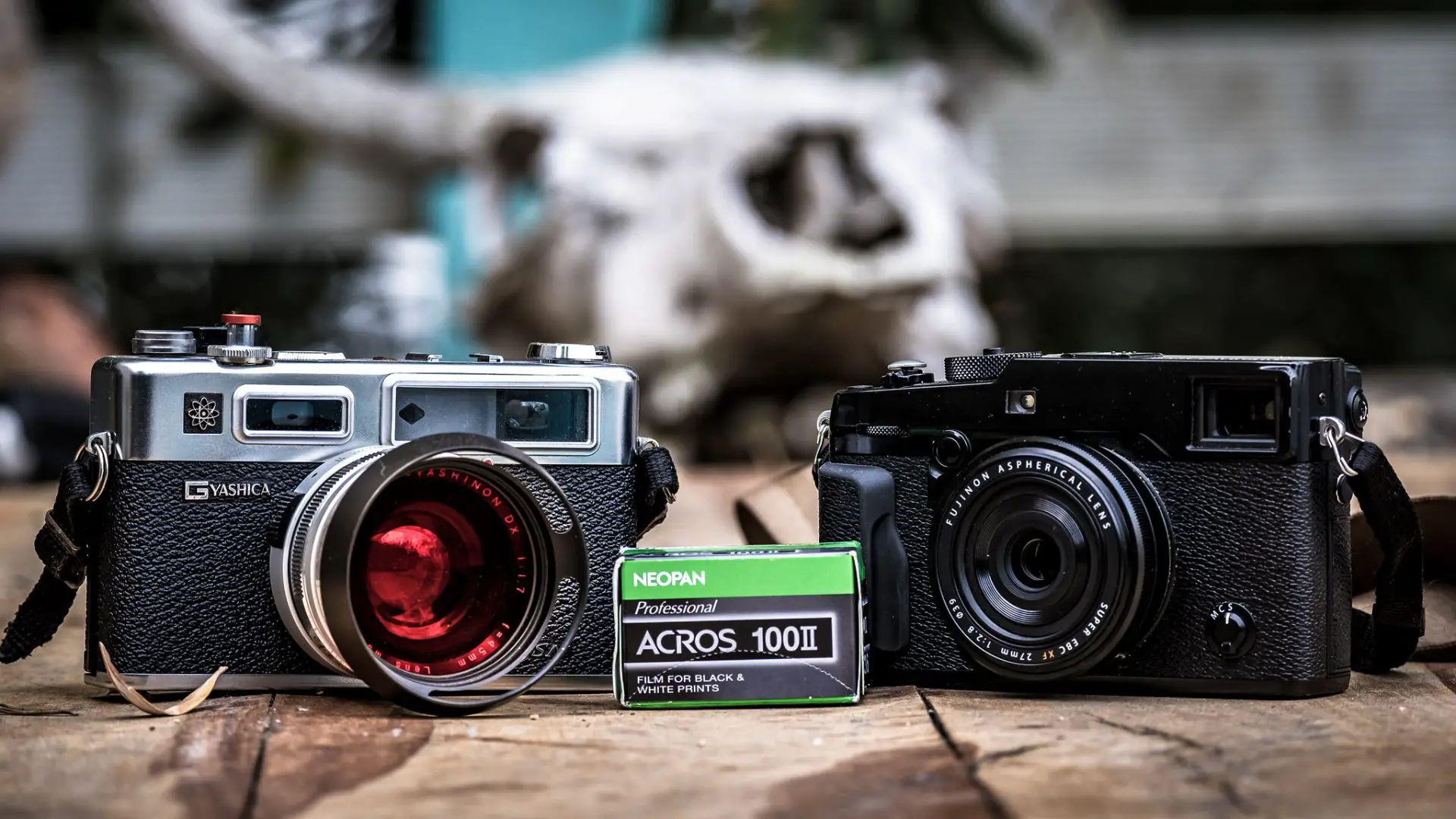








Comments
Rob Biondo on Fujifilm X-Pro3 Acros-R digital vs. 35mm Acros 100II – By Dale Rogers
Comment posted: 10/04/2020
As good as the XPro3 seems to be in terms of emulating Acros, unfortunately it looks like just that, an emulation.
The real Acros shot feel and look much better in my opinion. The images are bolder, they're better defined and have much better defined character. The grain and the much more defined contrast makes them stand out more (even before reading which was which, I could tell which was film and which was digital).
And they have precisely that timeless look and character which you point out film gives. Don't get me wrong, the XPro3 are great images but they leave me wanting more.
Comment posted: 10/04/2020
Comment posted: 10/04/2020
Comment posted: 10/04/2020
Frank Lehnen on Fujifilm X-Pro3 Acros-R digital vs. 35mm Acros 100II – By Dale Rogers
Comment posted: 10/04/2020
I basically should like the film images more... (www.whyfilmcameras.com) though those last days, weeks, months, photography was on a slow burner. Here I prefer the digital ones. Strangely. I think stand developing Acros in Rodinal is leading to much exaggerated grain and contrast. And that from someone who loves grain and contrast... and Rodinal!
Then again the dynamic range is much greater in the X-Pro images. And sorry to say, but your negs are quite dusty and scratched. Sorry but I had to mention that.
Comment posted: 10/04/2020
Scott Edwards on Fujifilm X-Pro3 Acros-R digital vs. 35mm Acros 100II – By Dale Rogers
Comment posted: 10/04/2020
Comment posted: 10/04/2020
Evan Bedford on Fujifilm X-Pro3 Acros-R digital vs. 35mm Acros 100II – By Dale Rogers
Comment posted: 10/04/2020
Comment posted: 10/04/2020
Chalky on Fujifilm X-Pro3 Acros-R digital vs. 35mm Acros 100II – By Dale Rogers
Comment posted: 10/04/2020
Peter on Fujifilm X-Pro3 Acros-R digital vs. 35mm Acros 100II – By Dale Rogers
Comment posted: 10/04/2020
Comment posted: 10/04/2020
greg cohen on Fujifilm X-Pro3 Acros-R digital vs. 35mm Acros 100II – By Dale Rogers
Comment posted: 10/04/2020
Comment posted: 10/04/2020
Todd W. Shaffer on Fujifilm X-Pro3 Acros-R digital vs. 35mm Acros 100II – By Dale Rogers
Comment posted: 10/04/2020
Great shots!
Comment posted: 10/04/2020
Charlie Bierwirth on Fujifilm X-Pro3 Acros-R digital vs. 35mm Acros 100II – By Dale Rogers
Comment posted: 10/04/2020
Comment posted: 10/04/2020
Charles Morgan on Fujifilm X-Pro3 Acros-R digital vs. 35mm Acros 100II – By Dale Rogers
Comment posted: 10/04/2020
Comment posted: 10/04/2020
Huss on Fujifilm X-Pro3 Acros-R digital vs. 35mm Acros 100II – By Dale Rogers
Comment posted: 10/04/2020
I too have an XP3 w 27mm lens. It is a really nice set up. But man, in your pics, I much prefer almost all the film shots. They just have, as the French say, that certain something about them.
;p
A snap, a depth, a more timeless feel.
I've been using my XP3 as a colour jpeg shooter, well that was the plan but I got it just before the lock down so haven't really been able to do too much. Doesn't help that I nearly always grab a film camera anyway..
Comment posted: 10/04/2020
Neal A Wellons on Fujifilm X-Pro3 Acros-R digital vs. 35mm Acros 100II – By Dale Rogers
Comment posted: 10/04/2020
Comment posted: 10/04/2020
Dmitri on Fujifilm X-Pro3 Acros-R digital vs. 35mm Acros 100II – By Dale Rogers
Comment posted: 10/04/2020
Comment posted: 10/04/2020
Dustin on Fujifilm X-Pro3 Acros-R digital vs. 35mm Acros 100II – By Dale Rogers
Comment posted: 10/04/2020
Comment posted: 10/04/2020
Mike on Fujifilm X-Pro3 Acros-R digital vs. 35mm Acros 100II – By Dale Rogers
Comment posted: 10/04/2020
One issue with the JPGs is that they’re one specific interpretation of Acros. As you’re well aware, you can process the same film in vastly different ways and get vastly different results. The JPGs, on the other hand, are what they are.
I love my Fuji cameras, but I’ve never been that enamoured of the built-in JPGs (B&W or colour). The raw files offer so much latitude for interpretation (similar, one might argue, as B&W film does), that I’ve never really understood relying on the imitations of a baked-in result.
Oh, and nice photos, BTW. I enjoyed the series!
Comment posted: 10/04/2020
Nathan Brayshaw on Fujifilm X-Pro3 Acros-R digital vs. 35mm Acros 100II – By Dale Rogers
Comment posted: 11/04/2020
Comment posted: 11/04/2020
Bill Mattocks on Fujifilm X-Pro3 Acros-R digital vs. 35mm Acros 100II – By Dale Rogers
Comment posted: 11/04/2020
Comment posted: 11/04/2020
eric on Fujifilm X-Pro3 Acros-R digital vs. 35mm Acros 100II – By Dale Rogers
Comment posted: 11/04/2020
I prefer the film. Really.
For me : the rendering of film is better than digital.
I use both digital and film from many cameras, films, ... your review confirms that film is poetic and great, and gives more fun. So thank you again, and the pictures are great.
Comment posted: 11/04/2020
Trung Vu on Fujifilm X-Pro3 Acros-R digital vs. 35mm Acros 100II – By Dale Rogers
Comment posted: 11/04/2020
Comment posted: 11/04/2020
Nick Colburn on Fujifilm X-Pro3 Acros-R digital vs. 35mm Acros 100II – By Dale Rogers
Comment posted: 11/04/2020
Comment posted: 11/04/2020
Bb on Fujifilm X-Pro3 Acros-R digital vs. 35mm Acros 100II – By Dale Rogers
Comment posted: 11/04/2020
Comment posted: 11/04/2020
Joe Jason Cummings on Fujifilm X-Pro3 Acros-R digital vs. 35mm Acros 100II – By Dale Rogers
Comment posted: 11/04/2020
Comment posted: 11/04/2020
Dmitry on Fujifilm X-Pro3 Acros-R digital vs. 35mm Acros 100II – By Dale Rogers
Comment posted: 11/04/2020
But anyway it’s not even close enough for those who had a real film experience once in the life.
Is there any ‘true’ and complete film simulation today? In-camera – no, for sure, I did try and all sucked more or less.
Software? There are some good tools, and Dehancer, by far, is the newest and the promising one. It even has push/pull states sampled from real darkroom prints. Pity standalone version is in early beta stage and mac-only (but it’s working and free), good news – they released a truly amazing ofx plugin for DaVinci this year, and it has dozens of films, lifelike grain and even bloom effect, all very realistic and close as hell to real film.
Nick Hood on Fujifilm X-Pro3 Acros-R digital vs. 35mm Acros 100II – By Dale Rogers
Comment posted: 11/04/2020
Anton Yakovlev on Fujifilm X-Pro3 Acros-R digital vs. 35mm Acros 100II – By Dale Rogers
Comment posted: 11/04/2020
Lens of Yashica is definitely a part of the equation here. It does wonders with contrast. Images are punchy, but it's not just a steeper curve. It seems to add contrast exactly where it is needed. Older 50/1.7 for Contax/Yashica mount worked like that too.
Comment posted: 11/04/2020
Len on Fujifilm X-Pro3 Acros-R digital vs. 35mm Acros 100II – By Dale Rogers
Comment posted: 11/04/2020
Personally I like the film shoots better however I wonder how much tweaking went into your scans? What settings were used on the Pro 3? The post processing needs to be similar.
Regardless, I see similarities between Acros the film and Acros the emulation. Fuji has done a nice job with their products. I hope that they see the value of continuing to support the film side the business (beyond Instax) while also expanding and developing their digital lineup.
Comment posted: 11/04/2020
Guilherme Amaral on Fujifilm X-Pro3 Acros-R digital vs. 35mm Acros 100II – By Dale Rogers
Comment posted: 11/04/2020
It's one more example that we cannot forget our Analog Cameras, How beautiful is the Analog Life, right?
Comment posted: 11/04/2020
Joe on Fujifilm X-Pro3 Acros-R digital vs. 35mm Acros 100II – By Dale Rogers
Comment posted: 11/04/2020
These make me miss the island and getting in the water. Bring on next summer! Where were these shots taken?
Comment posted: 11/04/2020
Sroyon on Fujifilm X-Pro3 Acros-R digital vs. 35mm Acros 100II – By Dale Rogers
Comment posted: 12/04/2020
Bruno Chalifour on Fujifilm X-Pro3 Acros-R digital vs. 35mm Acros 100II – By Dale Rogers
Comment posted: 18/04/2020
Bruno Chalifour on Fujifilm X-Pro3 Acros-R digital vs. 35mm Acros 100II – By Dale Rogers
Comment posted: 18/04/2020
1-why say the Acros-film photographs look more timeless?
2-the treatment of the highlights depends on processing in both film or digital and you can get soft Acros negative as well as contrasty digital file. How can the contrast of the Acros images be judged as representing what the film does: they just expose the photographer's choices (choice of film/exposure/processing and scanning). I could easily get the opposite results from this roll of film and the digital files. As for the grain I have never got such a coarse grain with the old Acros, and I doubt the new one (2nd generation) is meant to give us even coarser grain, thence this is the result of too powerful a developing process (too strong/concentrated developer, or too much agitation, or too high a processing temperature), not the inherent capacities of the film.
3-there is no "Acros out of the box" as such, the resulting images can be extremely modified by its exposure and its processing. Frank is right that the way Rodinal worked here (its dilution, agitation and temperature) produced excessive grain and contrast, especially for 100 ISO film.
As a note, Dale, stop using a squeegee to eliminate water drops from the negative, it is a well-known killer and scratcher, make sure you use a wetting agent in the last bath, and if you process on reels, hold the reel in your hand and with your arm starting from the upright position move it all the way down to your knees several times in a half circle whose radius is your extended arm. Just like for lettuce, it will remove the excess water. Then make sure your film dries in a critically dust-free environment (the wet and swollen gelatin of the film is extremely sticky).
And Dale, thank you again, I think you gave evidence than two different tools give different results under the same light but most important it broadened your experience of your own photography. Looking at the results I would modify my way to process Acros II film... but it is a matter of personal taste (as long as you can also produce less grainy and contrasty images with the same film when you need them). Best,
J. on Fujifilm X-Pro3 Acros-R digital vs. 35mm Acros 100II – By Dale Rogers
Comment posted: 30/07/2020
Martin on Fujifilm X-Pro3 Acros-R digital vs. 35mm Acros 100II – By Dale Rogers
Comment posted: 20/08/2022
Geri Laszlo on Fujifilm X-Pro3 Acros-R digital vs. 35mm Acros 100II – By Dale Rogers
Comment posted: 06/11/2023
In the first pair I really like the digital's softness, while the film's harshness is more dramatic. It is kind a draw.
In the second pair for me the digi is the clear winner. It is a very busy compo that shouts for more details, and the digi gives it.
Third, fourth pairs - no question, the film wins, easily.
The beachy-watery stuff... I don't know... I guess the digi one was taken later, and it is missing the effect of the Sun, and completely missing the clouds. On the other hand as it is softer it gives kind of a "mermaids are singing" feeling. I think I would go with the digital one...
The corner of the house is weird. The digital one looks like out of focus, or only a small part of the flowers are in focus. As I guess the subject was the house, so it does not seem to me a fair comparison. Here I'd like to take parts from both: the house from the film, and the foreground looks much better on the digital one.
The broken tractor is again an easy win for the film, it is just more dramatic, and as it is broken, there WAS drama...
The last pair again produces mixed feelings. This time the film's foreground looks better with the trees on both sides, but the house and the sky with the overcast with it's softness makes it more tale-like in the digital one.
I guess my opinion does not help too much, soooo undecided... I am not sure which would I pick if I had to for good and use only that one from that point...